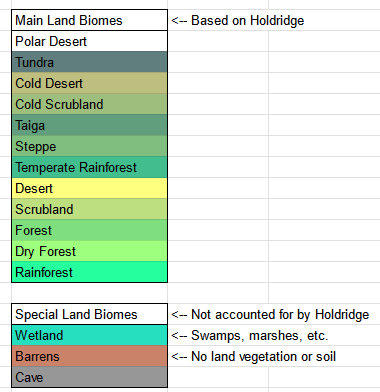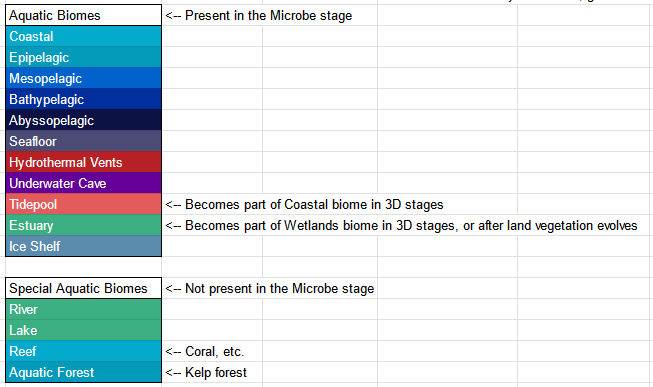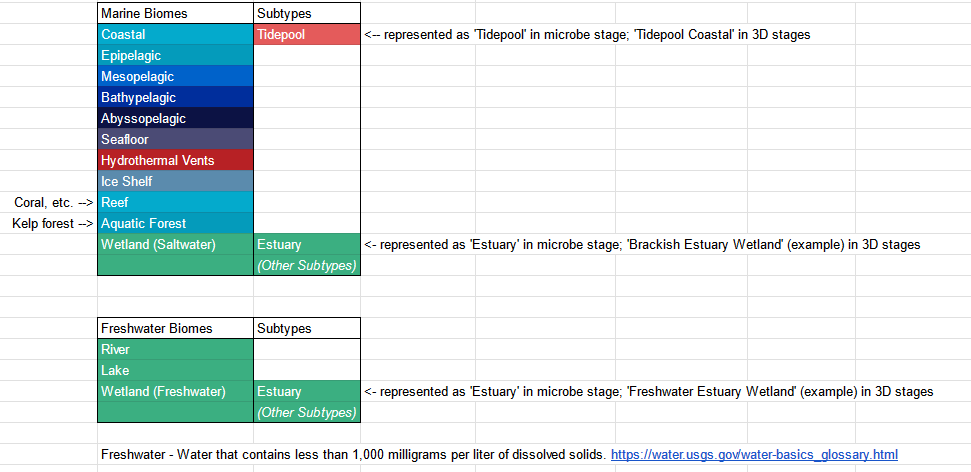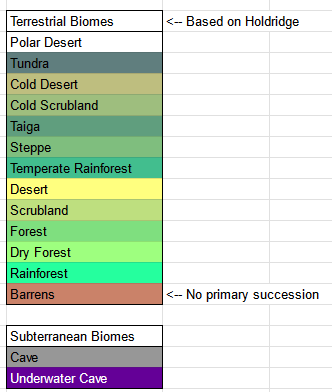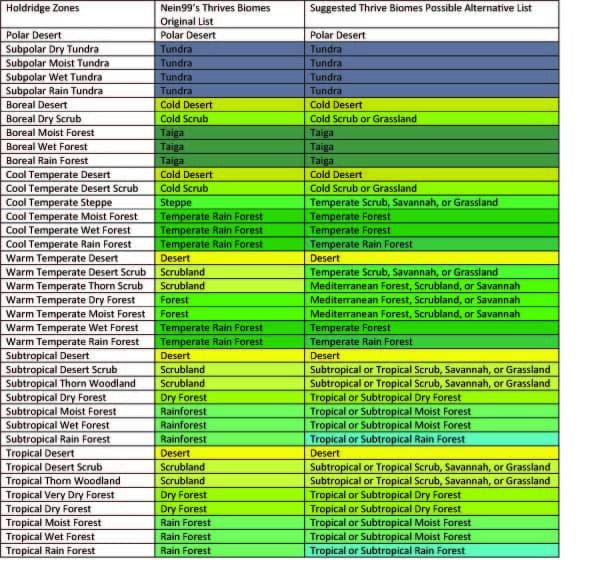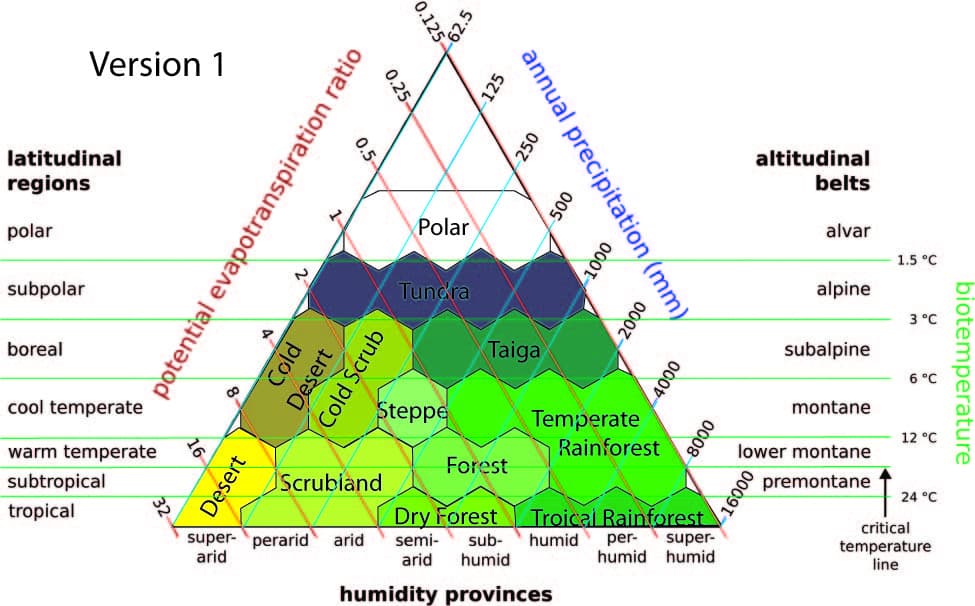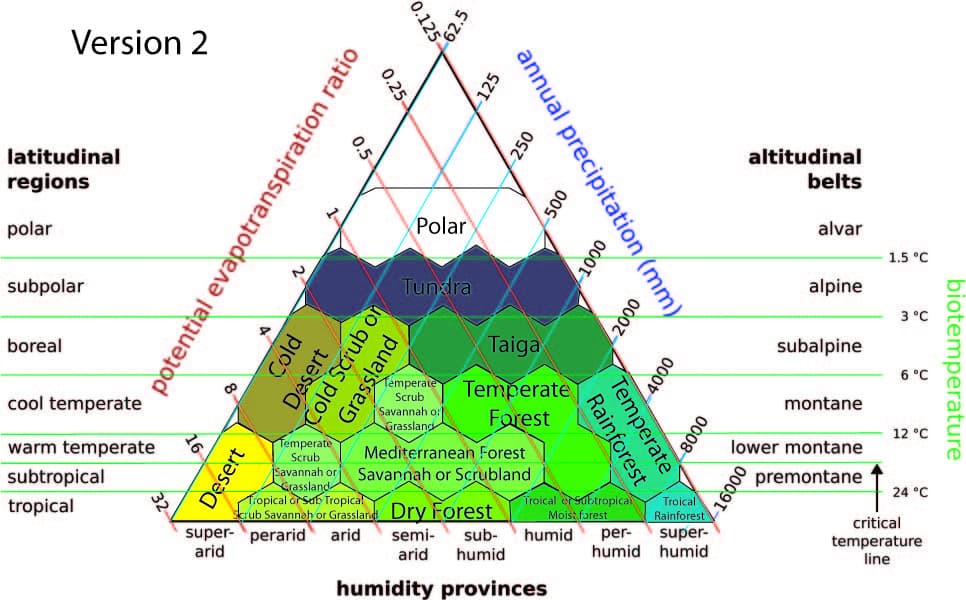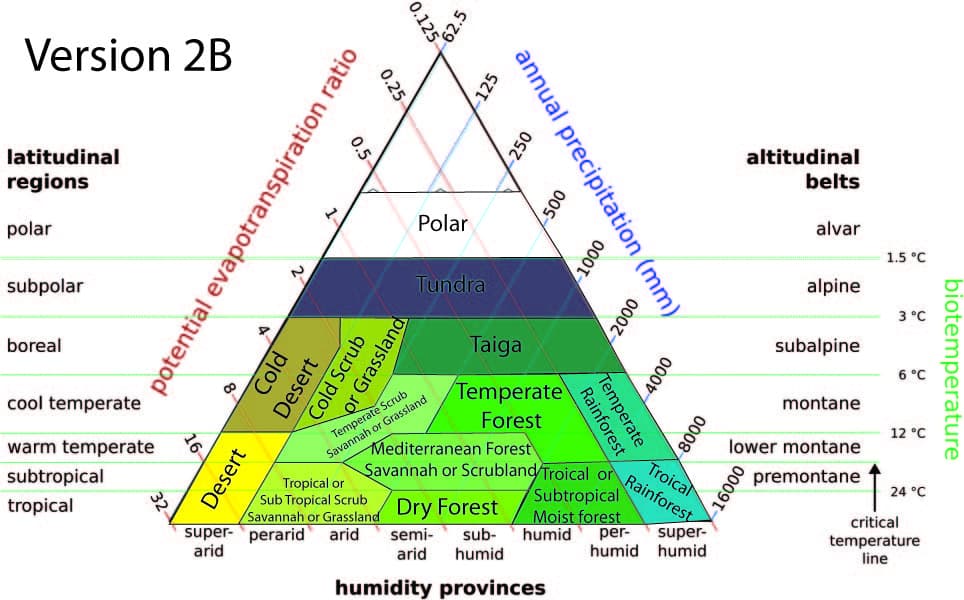This isn’t really comprehensive, and I’ve no idea how/if any of this will be implemented, but:
Reefs
Animal External Biomes
• Follicle Jungle
• Feather Jungle
• Whale (Barnacle have Commensalism relations with them (does not affect the whale at all for better or worse, but helps the barnacle))
Animal Internal Biomes
• Respiratory System
• Circulatory System
• Digestive Tract
• Reproductive System
• Brain
Plant Internals
Edit: So it turns out Geological reefs are a thing. So:
Reefs
- Biotic (Coral, Oyster, Sponge, (Non-Earth Species Here), Etc.)
- Fringing Reef
- Barrier Reef
- Atolls
- Geological
- Coastal
- Epipelagic
- Mesopelagic
- Bathypelagic
- Abyssopelagic
- Artificial (Ship Wreck, Construction Debris, Class Project, Etc.)
Edit Alright, here is everything I have worked on towards 1.x. Biomes (I am also working on Anthropogenic Biomes, but those are for 5.x)
Plants That Define Biomes
Definitions:
Avascular (Non-Vascular) Plants: Lack Xylem, Phloem, Roots, Stems, or Leaves. NOTE: Terrestrial Avascular Plants do not require soil. In fact, they predate and helped to create it, paving the way for other plants.
Vascular Plants: Evolved Xylem, Phloem, Roots, Stems, and Leaves. NOTE: Some secondarily lost these.
Aquatic Vascular Plants: Plants that, like mammals, developed on land, then secondarily returned to water.
Wood-y: A vascular plant that produces wood as its structural tissue and thus has a hard stem.
Tree Fern: Members of the order Cyatheales
Softwood (AKA: Gymnosperms): “Naked-Seed” producing plants. Includes Conifers, Cycads, Ginkgo, and Gnetophytes
Hardwood (AKA: Wood-y Angiosperms, Broadleaf): Flowering/Fruit bearing wood-y plants. All non-Cyatheales or Gymnosperm Wood-y Plants,
Herbaceous Plant (AKA: Ferns (other than Cyatheales) and Fern Allies and Non-Wood-y Angiosperms): A vascular Plant with no persistent wood-y stems above ground.
Fern and Fern Allies: Seedless Vascular Plants. Includes Horsetails. NOTE: A few Ferns appear to be Wood-y/Herbaceous Hybrids, but are classified as Herbaceous and not as Wood-y. There are also Tree Ferns.
Grass-Like: Grasses, Sedges, and Rushes
Grasses: Includes Cereal grasses, the grasses natural Grasslands (Savannahs and Prairies), cultivated grasses for Lawns and Pastures, Reeds, and Bamboo
Forb: Herbaceous Flowering Non-Grass-like Plant
Scrubland, Savannahs, and Grasslands:
Scrublands: Dominated by Wood-y or Herbaceous Scrubs
Savannahs: A mixed Woodland/Grassland Biome characterized by the trees being sufficiently widely spaced so that the canopy does not close.
Grasslands: Dominated by Grass-like Plants and Forbs
Softwood, Mixed, and Hardwood Forests:
Whether the forest (or rain forest) is composed of all Softwood, all Hardwood, or a mix of the two.
Notable Subtypes of Aquatic Vascular Plants:
Submergent Plants: Rooted plants that have most of their structures below water. Examples: milfoils and wild celery.
Emergent Plants: Rooted underwater but emerge or have a large portion of their shoots, leaves, or flowering structures out of the water. Examples: cattails, bulrushes, wild rice, sedges, bur-reed, honeysuckle, and milkweed.
Floating Leaf Plants: Rooted underwater but also floating. Example: water lilies.
Free Floating Plants: Non-rooted vascular aquatic plants. Examples: duckweed, water hyacinths, and water lettuce.
Notes about aquatic plants:
Seaweed (Aquatic Forests) are Submergent or Free Floating Multicellular Macroscopic Algae. They can be Red, Brown, or Green (Defined by Subtypes of Photosynthesis (they absorb different light colors)).
Seagrass (Marine Grassland) represent all known Submergent or Emergent Saltwater Herbaceous Plants.
Freshwater Herbaceous Plants can be Submergent, Emergent, Floating Leaf, or Free Floating.
All known Wood-y Aquatic Plants are Emergent.
Types of Wetland:
Estuary: Where ocean water and river water come together. All estuaries are Tidal Wetlands.
Intertidal: Places that are above water at low tide and above water at high tide. When salt-resistant vascular plant life is present in sufficient quantities, they are considered Saltwater Tidal Wetlands.
Floodplains: Places where overflow from rivers and lakes result in wetlands.
Swamp: A forested wetland.
Marsh: A wetland that is dominated by herbaceous plants rather than by belgium plants.
Peatland: A type of wetland whose soils consist of organic matter from decaying plants, forming layers of peat. Peatlands arise because of incomplete decomposition of organic matter, usually litter from vegetation, due to water-logging and subsequent anoxia.
Peat Swamp: A forested Peatland.
Fen: A type of peat-accumulating wetland fed by mineral-rich ground or surface water
Bog: A Peatland where the water at the ground surface is acidic and low in nutrients.
Vernal Pools: A seasonal wetland that goes through cycles of inundation from rain/precipitation, followed by desiccation from evapotranspiration. Some pools may remain at least partially filled with water over the course of a year or more, but all vernal pools dry up periodically. Typically, though, a vernal pool has three phases each year: it is inundated in the winter (inundated phase) with the vernal pool holding onto the water from 10–65 days, it dries slowly during the spring (flowering phase), and it dries completely during the summer (dry phase).
Important Plant Types by Biome
Subterranean: Some Algae do not require sunlight
- Cyanidiophyceae (Terrestrial Red Algae) (Thrives in Hot Acidic conditions like sulfur hot springs)
- Myco-heterotrophs
Marine:
- Avascular
- Phytoplankton (Includes Microalgae)
- Macroscopic Algae (Aquatic Forest Plants): Seaweed
- Marine Red Algae (Blue (shortest) Light)
- Brown Algae
- Kelp (Anchored)
- Sargassum (Free Floating)
- Marine Green Algae
- Marine Flowering Non-Wood-y Plant (Aquatic Grassland Plants): Seagrass (Fully Aquatic)
- Salt Resistant Herbaceous Plants (Saltwater Marsh Plants) (Semi-Aquatic)
- Marine Wood-y Plants (Saltwater Swamp Plants)
- Marine Softwood (I have yet to find an existing example)
- Marine Hardwood (Mangroves)
- Marine Floating Plant (I have yet to find an existing example)
Freshwater:
- Freshwater Algae
- Freshwater Herbaceous Plants
- Aquatic Ferns and Fern Allies
- Flowering Freshwater Non-Wood-y Plants (Freshwater Marsh Plants)
- Freshwater Wood-y Plants (Freshwater Swamp Plants)
- Freshwater Softwood
- Freshwater Hardwood
Terrestrial Plants
- Terrestrial Non-vascular Plants (Do not require Soil) (Can survive in Barrens and Bog)
- Bryophytes (liverworts, hornworts, and mosses)
- Terrestrial Green Algae
- Cyanidiophyceae (Terrestrial Red Algae)
- Wood-y Plants
- Tree Ferns
- Softwood
- Trees (Rainforest, Forest, Taiga)
- Shrubs (Scrubland and Savannah)
- Hardwood
- Trees (Rainforest, Forest)
- Shrubs (Scrubland and Savannah)
- Wood-Stemmed Vines (Liana)
- Wood-like Grass (Most (but not all) Bamboo) (Forest)
- Herbaceous Plants
- Ferns and Horsetails (Except Tree Ferns)
- Flowering Terrestrial Non-Wood-y Plants (Savannah and Grasslands)
- Grass-like (other than Wood-Like Bamboo)
- Forb (flowering Herbaceous Non-Grass-like plant (which I wrongly called wild flowers earlier), I believe this includes most vines)
New Biome Types and Subtypes
Marine
- Saltwater Lake
- Reef
- Biotic (Fringe Reefs, Barrier Reefs, and Atolls) (ex. Tropical Coral Fringe Reef)
- Geological (Defined based on Zone) (ex. Temperate Geological Mesopelagic Reef)
Artificial (Can wait until 5.8.x)
- Aquatic Forest (Seaweed (Kelp))
- Marine Meadow (Seagrass)
- Wetlands (Saltwater)
- Estuary (Swamp or Marsh)
- Intertidal (Swamp or Marsh)
- Floodplains (Saltwater) (Swamp or Marsh)
Freshwater
- Lake/Pond
- River/Stream
- Wetlands (Freshwater)
- Estuary (Swamp or Marsh)
- Floodplains (Freshwater) (Swamp or Marsh)
- Peatland (Peat Swamp, Fen, or Bog)
- Vernal Pools
Subterranean
- Deep Cavern
- Void (ex. An air pocket not connected to the surface (but could be connected to water, or a sea of lava))
- Saltwater Underwater Cavern
- Freshwater Underwater Cavern
- Underground Lake
- Underground River
A Suggested Alteration to Biome Classification
Note: Any forest can be: Softwoofd Hardwood, Mixed, or Fern
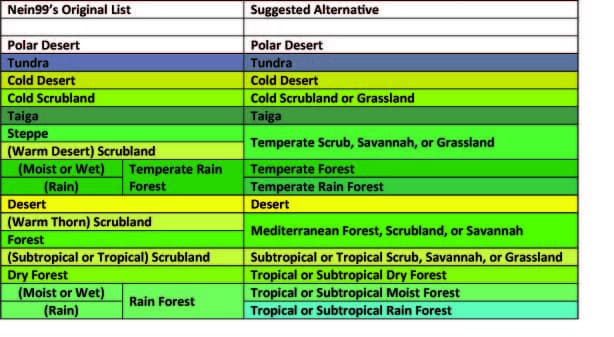
Wow, now I know not change font size, use bold, or underline in Word, or to color code or merge cells in a table, BEFORE posting. That did not copy/paste well at all.
Edit: Betterish.
Edit: And now the first Table is legible, sort of.
Edit: Fixed a typo and added Tree Ferns.
Edit: For Graphical Comparison
Note: If you would like a version 3, just ask.
Edit: For the record, I based the differences off “Olson & Dinerstein (1998) biomes for WWF / Global 200”
about halfway down Wikipedia’s entry for Biome. I chose not to distinguish Conifer (Softwood) or Broadleaf (Hardwood) forests because I feel that could go any way on another world. Though Thrive may wish to specify sub-types in game.
Edit: Fixed a line issue in the corner of Cart V2
Edit: Kept thinking something looked off about version 2, so I though I would see if this looked better. Needs work.
Edit: And here we have a prototype of Anthropogenic Biomes. It needs work, but its something to think on and discuss at least.
5.8.x: Anthropogenic Biomes
Farm: An area of land dedicated to growing consumables and/or domesticated animals.
Plantation: A large Farm dedicated to one specific crop.
Ranch: An area of land dedicated to raising livestock.
Arable Land: Cropland that requires yearly replanting. (Example: Root Vegetables)
Permanent Cropland: Cropland that can be re-harvested without replanting. (Example: Fruit Trees)
Rangeland/Pasture: Places for grazing livestock. Rangelands have primarily native vegetation and pastures are more intentionally grown with seeding, irrigation, and fertilizer.
Aquaculture: Farm for aquatic organisms such as fish, crustaceans, mollusks, algae and other organisms of value such as aquatic plants.
Agricultural Land
- Farmland
- Arable Land Plantation
- Arable Crops
- Most Cereal Grain (Includes some but not all rice; on earth, includes all non-rice Cereal Grains)
- Timber Trees
- Permanent Cropland Plantation
- Fruit and Nut Trees
- Grapevine (Vineyard)
- Sugarcane
- Some Rice
- Non-Cropland Farmland
- Ranch
- Nectar Farm (Bee Farm: for Honey)
- Mixed/Cluster of Small Farms
- Rangeland/Pasture
Artificial Wetlands
- Semiaquatic and Aquatic Croplands
- Semiaquatic Paddy Fields (Flooded Arable) (Some Rice, Taro)
- Aquatic Deepwater Cropland (Water is more than 50 cm (20 in) deep for at least a month) (Some Rice)
- Freshwater Aquaculture
- Canals
- Reservoir
Urban
Marine
- Marine Aquaculture
- Submerged Structure
- Oil Spill
Subterranean Freshwater
- Subterranean Canals
- Flooded Mines
- Freshwater Pipes
- Sewage System
- Industrial Sewer
- Sanitary Sewers
- Storm Drain
- Combined Sewage System
- Industrial Waste River
Artificial Shoreline
Subterranean (Non-Aquatic)
- Landfill
- Artificial Cave-like System
- Underground Mine
- Subway
- Catacombs
- Utility Tunnels
- (Other Tunnel Network)
Destroyed and Abandoned Surface Areas
- Abandoned Excavation Site
- Open Pit Mine
- Strip Mine
- Mountaintop Removal Mine
- Abandoned Deforested Forest
- Abandoned Urban Area
Polluted (Biome Name)
- (Pollution Subtype)
- (Pollution Subtype)
